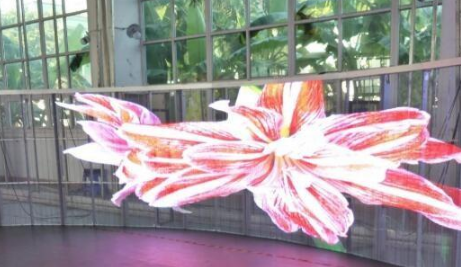
2021-12-24
admin
The resolution of the traditional LED transparent screen has been greatly improved, and the small-pitch LED transparent screen is a new product based on this. The small-pitch transparent screen refers to the product with the LED dot pitch of P2. At present, there are still three contradictions to be reconciled in the small-pitch LED display. If they cannot be properly resolved, it will greatly affect the use experience of the LED transparent screen:
1. Grayscale loss caused by brightness reduction
The most significant difference between indoor and outdoor display applications is the change in ambient light. When the LED transparent screen comes indoors, its brightness is required, but when the brightness of the transparent screen drops below 600cd/㎡, the screen begins to show obvious grayscale loss. As the brightness further decreases, the grayscale loss also increases. more and more serious. We know that the higher the gray level, the richer the colors displayed on the transparent screen, and the more delicate and full the picture.
Solution: The screen brightness is suitable for the ambient brightness and can be adjusted automatically. Avoid the influence of too bright or too dark environment to ensure normal picture quality. At the same time, the screen with high gray level is adopted, and the current gray level can reach 16bit.

2. The increase of dead pixels caused by the improvement of image quality
The small-pitch LED transparent screen is composed of many LED lamp beads, and the distribution is dense. The more the number of LED lamp beads per unit area, the higher the quality of the transparent screen, and the richer the display of picture details. However, due to technical defects, small-pitch transparent screens are prone to dead spots of lamp beads. Generally, the dead light rate of LED displays is controlled within 3/10,000, but for small-pitch LED transparent screens, the death rate of 3/10,000 is limited. The lamp rate cannot meet the needs of daily use. Take the P2 small-pitch LED transparent screen as an example, there are 250,000 lamp beads per square meter. Assuming that the screen area is 4 square meters, the number of dead lights will be 25*3*4=300, which will bring an unfriendly viewing experience to the normal screen display.
Solution: The dead light is generally the reason for the weak welding of the lamp beads. On the one hand, the production technology of the LED transparent screen manufacturer is not up to standard, and there is a problem with the quality inspection. Of course, the problem of lamp beads is not ruled out. Therefore, manufacturers must control the quality of raw materials according to the formal quality inspection process, and at the same time monitor the production process in place. Before leaving the factory, a 72-hour aging test must also be done, and the dead light problem must be checked and repaired to ensure that it is a qualified product before shipment.
3. The problem of heating caused by close-up viewing
Studies have shown that in the energy conversion process of LED screens, the electro-optical conversion efficiency is only about 20~30%, that is to say, only about 20~30% of the input electrical energy is converted into light energy, and the remaining 70~80% of the energy. All are consumed in the form of thermal radiation, therefore, the heat of the LED display is serious. The small-pitch LED transparent screen that generates heat for a long time will cause the indoor ambient temperature to rise. For indoor personnel, staying for a long time will be relatively uncomfortable, and even sitting in a relatively far away position, it is difficult for a long time. Keep a good attitude under the fever.
Solution: Using high-quality high-efficiency power supply can ensure high electro-optical conversion rate, thereby reducing the impact of heat.